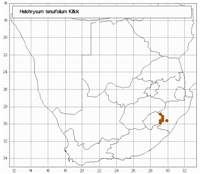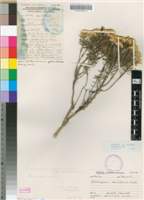Origin of name:
tenuifolium = with slender / narrow leaves
Diagnostic characters:
Needle-like leavesMedium sized headsCompact inflorescenceYellow bracts
Description:
Twiggy, rounded shrub up to 2 m high, old branches bare, rough with leaf bases, branchlets white-woolly, closely leafy. Leaves 7�18 x 1�1.5 mm, linear, apex mucronate, acute, hooked, base broad, half-clasping, margins revolute, upper surface with minute, elongated appressed trichomes, later glabrous or nearly so, lower surface white-woolly. Heads heterogamous, campanulate, 4�5 mm long and as much across the radiating bracts, bases woolly, many in compact terminal corymbose clusters 10�20 mm across. Involucral bracts in c. 4�5 series, graded, closely imbricate, glossy, outer palest brown often tipped reddish or orange when young, inner about equaling the flowers, tips obtuse, bright canary-yellow, minutely radiating. Receptacle shortly honeycombed. Flowers 27�45, 7�15 female, 19�30 homogamous. Achenes 0.75 mm long, with duplex hairs. Pappus bristles many, equaling corolla, scabrid, bases cohering by patent cilia.
Flowers in November and December.
Distribution:
Grows in colonies in rocky gullies, along streamsides, in boulder beds, among rock outcrops, or as a constituent of fynbos, above 1 650 m. Recorded from only the KwaZulu-Natal Drakensberg between Cathedral Peak and the upper Polela, west of Himeville.
Grassland Biome.
Notes:
Very showy. Can be confused with H. trilineatum, but has appressed trichomes, not gland dots, on the upper leaf surface.Taxonomy:
Literature:
Helichrysum tenuifolium Killick in Bothalia 6: 424 (1954); Hilliard, Compositae in Natal 204 (1977).
Type:
Lectotype: KwaZulu-Natal, Bergville distr., Cathedral Peak Forest Research Station, Killick 1591 (PRE; BM; K; NU; S, isolecto.).
Synonym(s):
Vouchers:
Hilliard & Burtt 9290 (E; K; NU; S); Schelpe 960 (NU); Wright (E; NH; NU).

